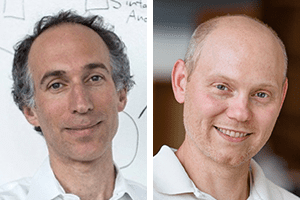Author: Sarah Robbins, PhD, 2019-2020 ASHG Genetics Education and Engagement Fellow

In March, ASHG hosted a webinar to share recent findings in the population genetics of ancient humans and to explore how genetic variation may have shaped early human history. This webinar, entitled, “New Insights into Ancient Genomes” featured ASHG members David Reich, PhD and Joshua Akey, PhD. During the session, they discussed methods for isolating ancient DNA, computational approaches for determining ancestry, and how extinct ancient species like Neandertals and Denisovans might still live in our DNA. The full recording is now available and viewable for free on demand.
Reich and Akey received so many questions during their Q+A that there wasn’t time to answer them all. Our speakers graciously responded to some additional questions below.
Attendee Question: Can we emerge the CRISPR technology with data science for better analysis and human genome editing?
Reich: CRISPR technology is extraordinary, but I’m not sure we are the right people to answer this question as we don’t have expertise in it.
Akey: CRISPR technology will be useful in understanding the functional and molecular consequences of mutations inherited from Neanderthal and Denisovan ancestors. Currently, the technology is limited by the number of edits that you can make so you can only look at a finite number of positions in the genome at one time, but as tools that enable larger numbers of edits to be made, it will be an increasingly useful technology.
Attendee Question: Have you compared and analyzed Neanderthal and Denisovan genomes with ancient modern human sequences?
Akey: There are a number of published analyses comparing Neanderthal and Denisovan genomes with ancient modern human sequences, and among the many interesting findings, are that these analyses suggest the initial Neanderthal admixture proportion was ~10% and examples of ancient modern human genomes with higher levels of Neanderthal ancestry have been found (although they didn’t contribute ancestry to contemporary individuals).
Attendee Question: There is evidence for a second Denisovan introgression into Papauns. Are there other patterns besides two pulses that could explain this pattern?
Reich: What we can be sure of is that there was not a single pulse of gene flow. There are many more complex scenarios of admixture with a diverse Denisovan population that could explain the available observations.
Attendee Question: To your knowledge, how many ancient genomes are available right now from East Asia?
Reich: It depends on how you define East Asia, but if you include eastern Siberia and the Baikal region and Mongolia as well as the Pacific islands it is well more than 200 individuals.
Attendee Question: Could you speculate the possibility of Neanderthal introgression in Arabian Peninsula area?
Reich: Arabian Peninsula populations today are mostly descended from people related to West Eurasians who all have Neanderthal admixture, so a guess would be that they have Neanderthal admixture too.
Attendee Question: When both ancient and modern humans have both alleles at a site and the difference is judged by the difference in frequency, might genetic drift and selection account for some of that difference and is this accounted for in the models?
Reich: Yes, there are expected to be differences in allele frequency between modern and ancient populations just like between two modern populations, and the differences reflect natural selection and genetic drift (and can provide information about those processes).
Akey: In addition, methods to identify introgressed sequences try and explicitly distinguish these signals of shared ancestry from sequences inherited through admixture.
Attendee Question: Is there more or less enrichment of archaic DNA in Y chromosome or mitochondrial DNA?
Reich: Less – there are no known cases of archaic admixture on the Y chromosome or mitochondrial DNA of modern humans. It is plausible that archaic mitochondrial sequences existed in past modern human populations, but we haven’t seen a case so far.
Attendee Question: Having recovered ~40% of Neanderthal genome from 1000 modern genomes, why don’t we have a Neanderthal mitochondrial haplogroup in modern humans?
Reich: This likely reflects either high genetic drift–known to be especially intense on mitochondrial DNA. With about ~60% of the autosomal genome having no known haplotypes derived from archaic humans due to drift, the probability of retaining archaic ancestry is even lower for mitochondrial DNA (because of the high drift).
We thank Drs. Reich and Akey for their insights into the study of ancient human populations. At the end of the seminar, Reich put it perfectly – “In the next ten years, we might learn as much about human biology as we have about human history.” We look forward to the new discoveries in this exciting area.
